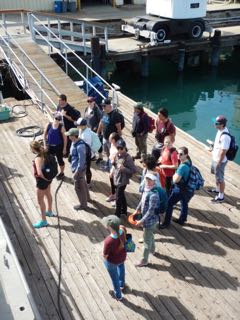
Our trip was on a very calm and warm day.
We left from Terminal Island in Los Angeles Harbor and did mud grabs, sandy bottom trawls, rock dredges, and plankton tows.
| 
-
| 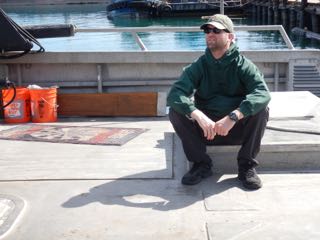
-
|
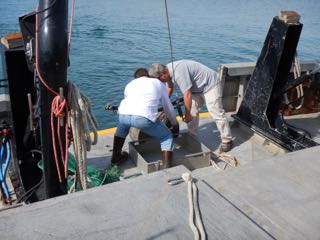
-
| 
Van Veen (mud) grab
| 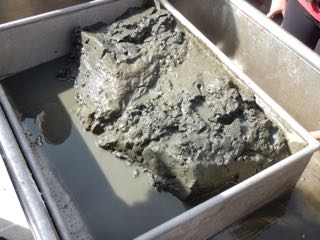
-
|
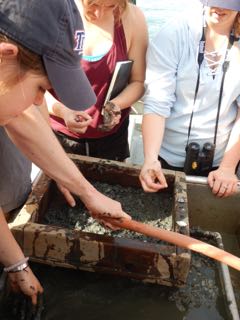
-
| 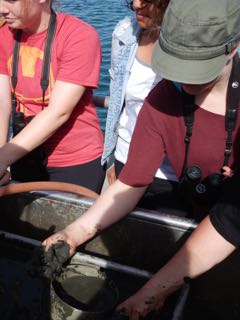
-
| 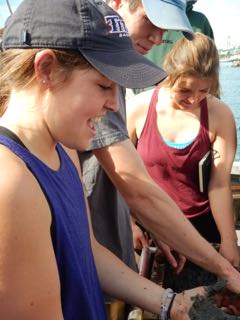
-
|
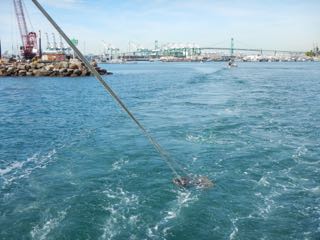
-
| 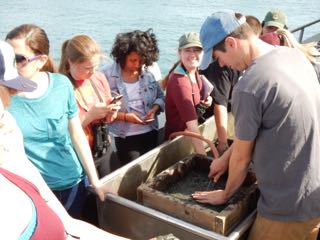
-
| 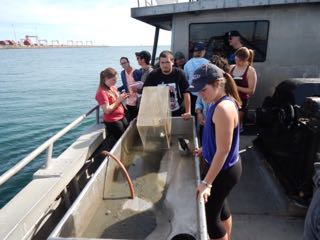
-
|
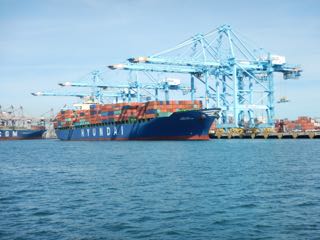
-
| 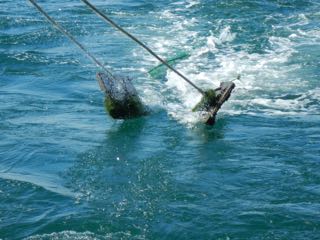
otter trawl sampling of soft bottoms, in this case about 22m depth just inside the harbor
| 
-
|
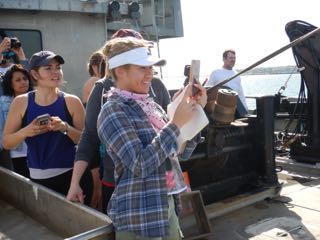
-
| 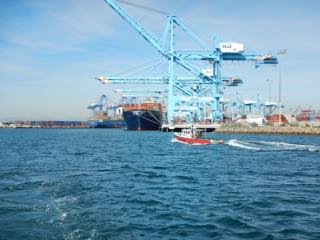
-
| 
-
|

-
| 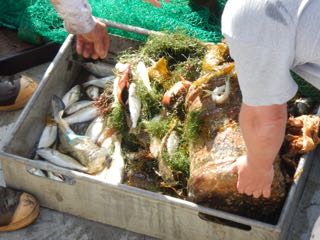
-
| 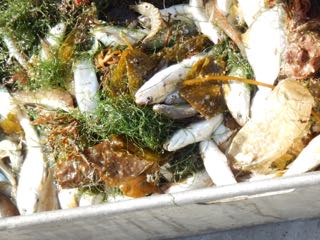
-
|

-
| 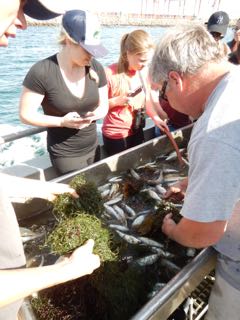
-
| 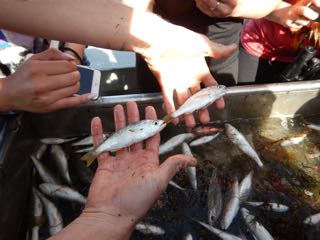
-
|
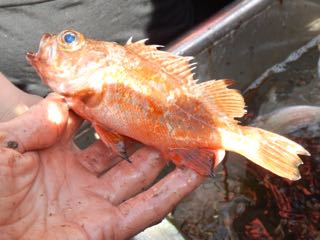
juvenile rockfish (not identified)
| 
-
| 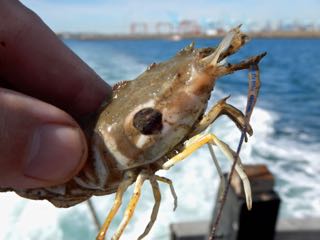
Spot prawns (Pandalus platyceros) are common from Alaska to
San Diego and are an important harvested species for British Columbia, and are considered to be sustainable fishery
resource there. I think this is unusual when it comes to fisheries of wild-caught shrimp because of damaging trawling
methods employed more normally for worldwide shrimp harvesting. This species changes from male to female with age, and
engages in nightly feeding migrations to shallower depths.
- Source: Aquarium of the Pacific
|
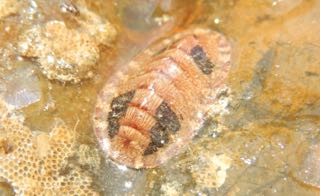
This is probably an unusually deep (22m)
example of a chiton that is common under rocks in the intertidal, Lepidozona pectinulata. Its appearance is
more delicate than is usually the case for intertidal individuals, but this could be due to sand scour. It is also interesting
that this was found on sandy bottom, attached to an empty 5-gallon water bottle, whereas I have never seen this species
at similar depths in rock dredges. This matches my impression that the most common chiton seen snorkeling on sandy bottoms
with few pieces of hard substrate is also this species.
| 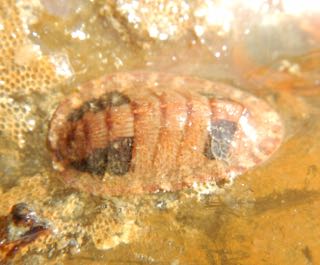
-
| 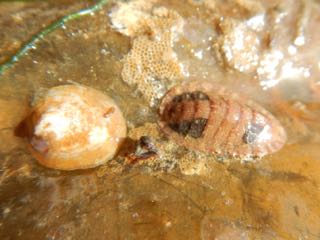
That is a slipper limpet (Gastropoda: Calyptraeidae) on the left.
|
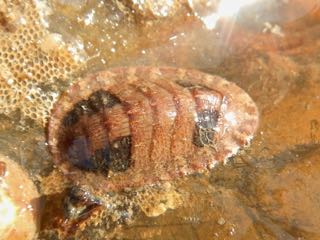
-
| 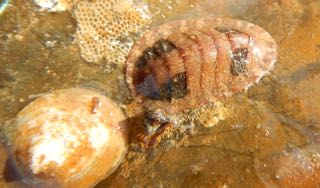
-
| 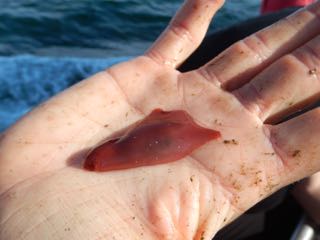
Because I am accustomed to seeing baby sea hares in the intertidal,
I was confused by the bright red color of this California sea hare juvenile, but it was living at 25m (80ft) depth, where there was
mostly red algae for this herbivore to eat. Apparently, you are what you eat.
- Source: Sea Slug Forum -
|

Red algae do well even at these depths because the red light
used by most green algae doesn't penetrate very deep, but red and brown algae have accessory pigments that capture the greenish light
wavelengths that do penetrate to these depths, then transfer the energy to their chlorophyll-a molecules for photosynthesis. Some green algae can
do this as well, apparently using chlorophyll-b.
For example, we found Codium hubbsii, a green alga (see below), in the same dredge.
Other algae can use chlorophyll-c or -d as well as carotenoids or phycobiliproteins.
- Source: Wikipedia
| 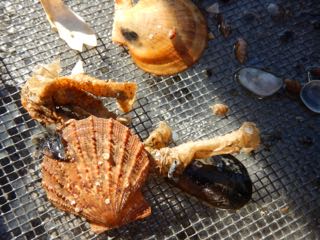
-
| 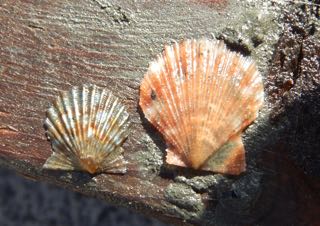
shells of kelp and rock scallop juveniles (Leptopecten latiauratus and Crassadoma gigantea,
respectively) (ID: Shawn Wiedrick)
|
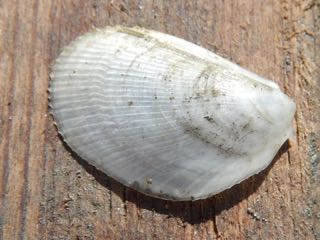
Limaria hemphilli
| 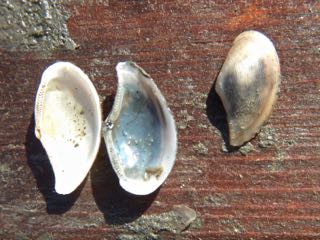
a protobranch bivalve, Nuculana taphira (ID: Shawn Wiedrick)
| 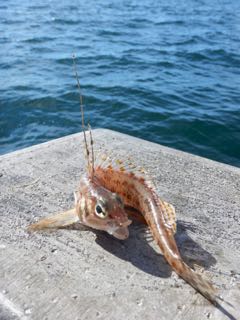
Zaniolepis latipinnis, longspine combfish
|
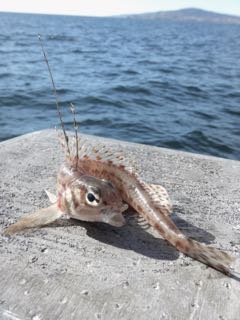
-
| 
-
| 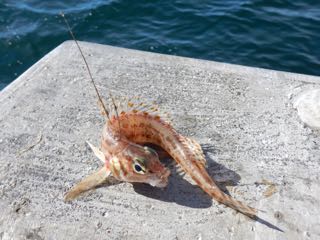
-
|
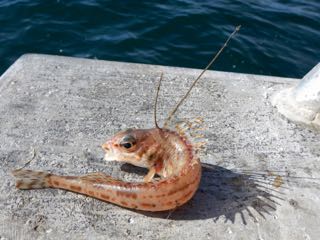
-
| 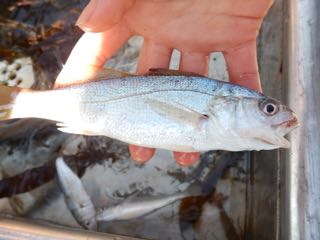
white croaker (Genyonemus lineatus)
| 
-
|

Xystreurys liolepis (fantail flounder, or fantail sole)
| 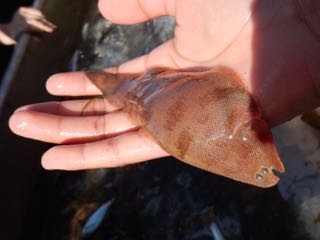
Symphurus atricaudus (California tonguefish)
| 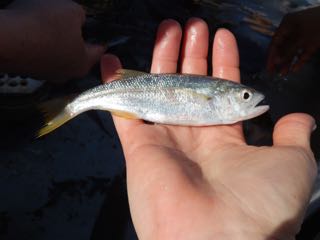
queenfish (Seriphus politus)
|

-
| 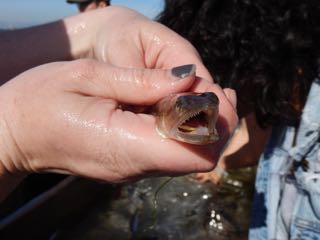
California lizardfish (Synodus lucioceps)
| 
-
|

-
| 
-
| 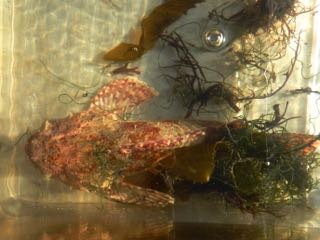
California scorpionfish (Scorpaena guttata)
|
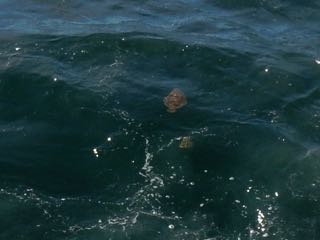
-
| 
collected in a biological (rock) dredge
| 
A sacoglossan, possibly Aplysiopsis enteromorpha (ID: Brenna Green)
|
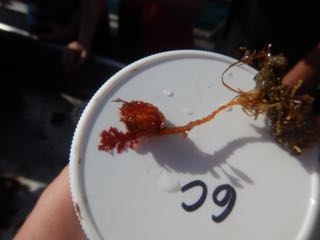
A solitary tunicate, Boltenia villosa, with a red alga attached.
We also saw another solitary tunicate, Styela montereyensis.
| 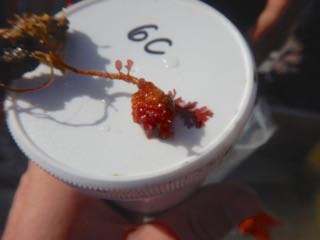
-
| 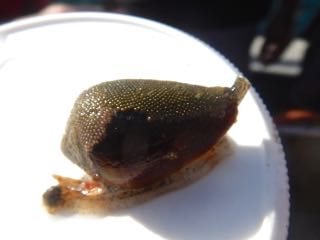
California cone snail (Californiconus californicus) with its shell encrusted by a bryozoan colony.
|
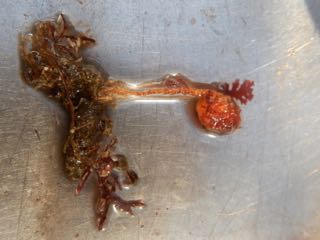
-
| 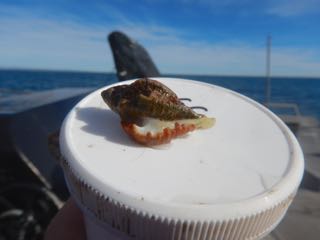
Maxwellia santarosana (Santa Rosana murex)
| 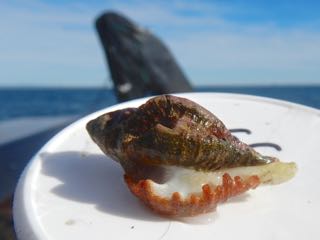
-
|
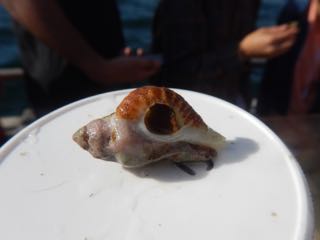
-
| 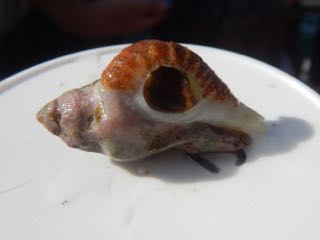
-
| 
-
|
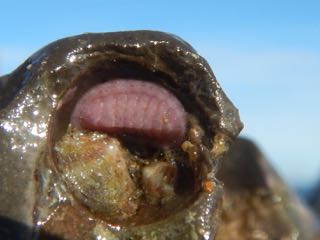
-
| 
-
| 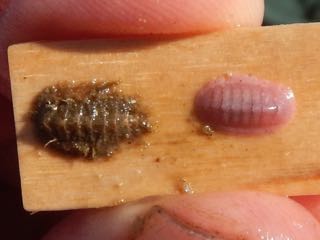
Tentative: Mopalia lowei (L) and Lepidozona cf. scrobiculata (R). Besides
these and the L. pectinulata above, we also found these chitons: two Callistochiton palmulatus, two
Dendrochiton thamnoporus, and one Leptochiton nexus.
|

-
| 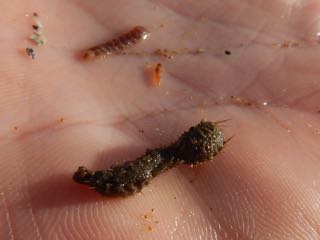
posterior fragment of a flabelligerid polychaete (ID: Leslie Harris)
| 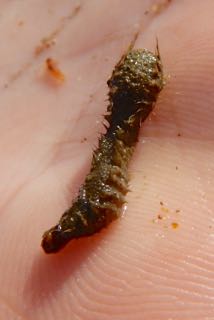
-
|

-
| 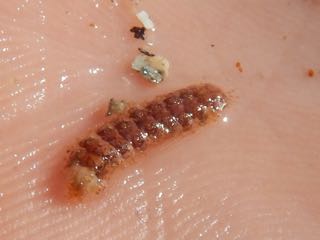
a scaleworm (Polynoidae), Thormora johnstoni (ID: Leslie Harris)
| 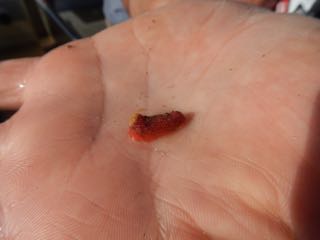
-
|
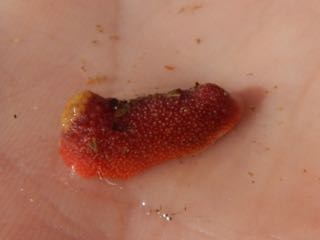
-
| 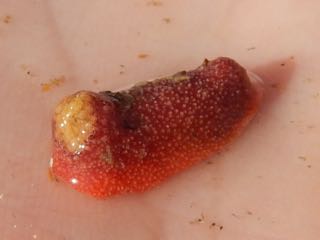
Psolid sea cucumbers, like this Lissothuria nutriens, are
modified to attach to substrates with a sole-like underside.
| 
Codium hubbsii is typically subtidal and prostrate,
meaning I assume it spreads out on the substrate. It is not especially closely related to the similar appearing, but more northern
and intertidal, C. setchellii. The latter is more irregular and tightly adherent to the substrate, usually in sandy areas, whereas C. hubbsii
tends to be approximately circular, with loose margins (ID and details: Kathy Ann Miller).
|

-
| 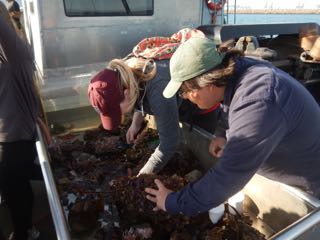
-
| 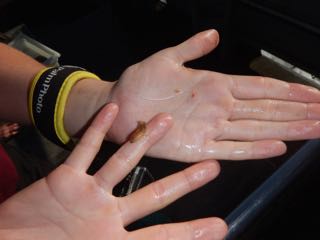
-
|
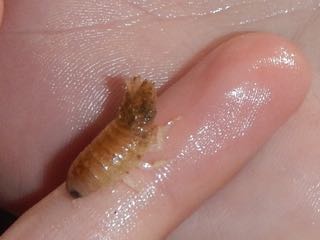
-
| 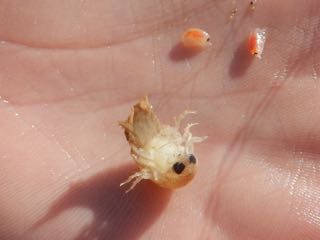
A pair of reddish amphipods found together, above an isopod,
both found in boring date mussel burrows in a mudstone rock split in half.
| 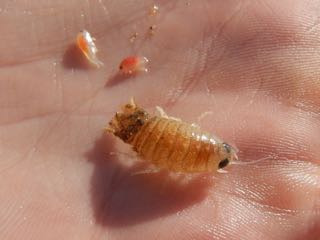
-
|
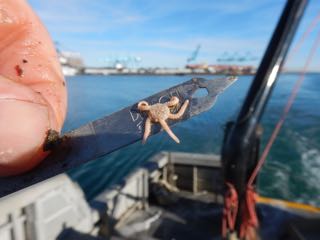
Ophioncus granulosus Ives, 1889 is the only species of this genus, one of about 24 genera in the
family Ophiodermatidae but the only representative for this family in Hendler's (2007) brittlestar chapter in Light and Smith Manual (ID: Gordon Hendler).
| 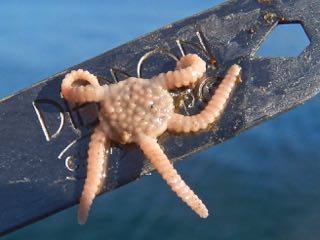
Ophioncus granulosus seems to have been little studied since Ives first described it
(see source 1) from an unknown locality among material from western North America, and a second known specimen was found by echinoderm expert,
Walter K. Fisher (see source 2). However, Hendler (2007: pp. 938-939, source 3) gave a good description of it and notes
that when a brittlestar of this species is suspended in midwater, it folds its arms concentrically on top of its disk, and sinks like a pebble.
Sources: 1 - 2 -
3
| 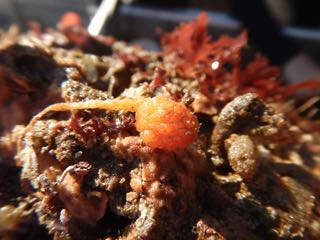
solitary tunicate, Boltenia villosa
|
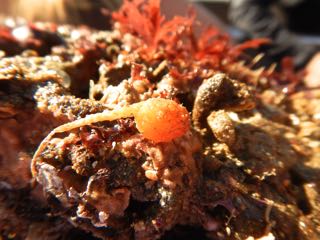
-
| 
-
| 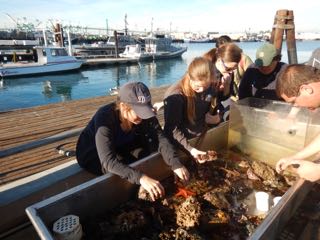
-
|
 Under Construction!
Under Construction! Under Construction!
Under Construction!